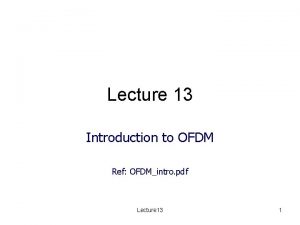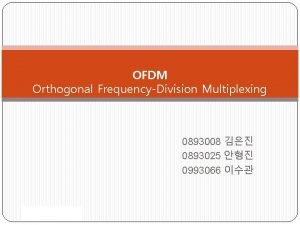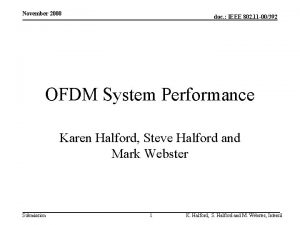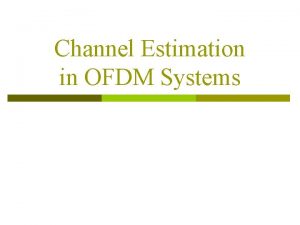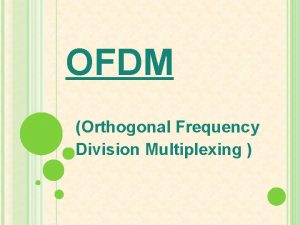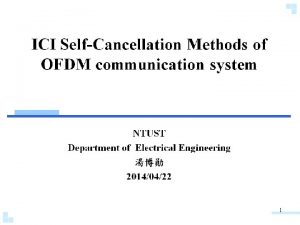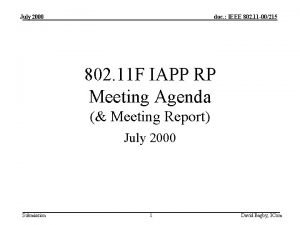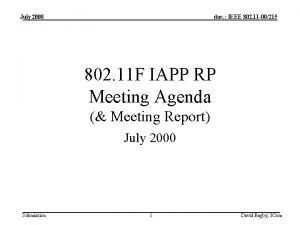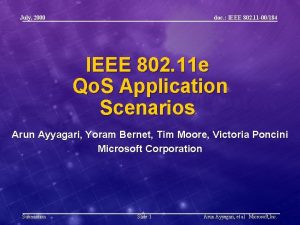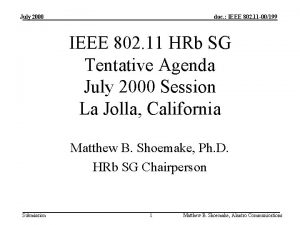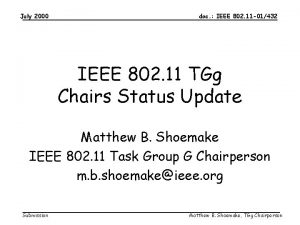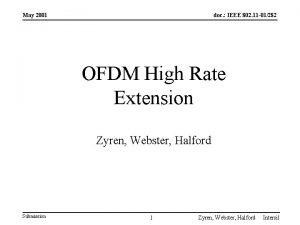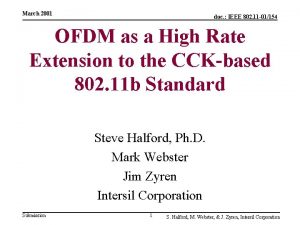July 2000 doc IEEE 802 11 00188 OFDM














- Slides: 14

July 2000 doc. : IEEE 802. 11 -00/188 OFDM in the 2. 4 GHz Band Jan Boer, Lucent Technologies Submission 1 Jan Boer, Lucent Technologies

July 2000 doc. : IEEE 802. 11 -00/188 Why OFDM in 2. 4 GHz • Standard is developing fast: – 2 Mbit/s in 1997 – 11 Mbit/s in 1999 – PAR for >20 Mbit/s in 2000 • What is next; can we go higher? • Yes; OFDM as specified in 802. 11 a can go up to 54 Mbit/s – also in the 2. 4 GHz band Submission 2 Jan Boer, Lucent Technologies

July 2000 doc. : IEEE 802. 11 -00/188 How? • Adopt 802. 11 a for higher rate in 2. 4 GHz • Fully specified for 6, 12, 18, 24, 36, 48, 54 Mbit/s • Maintain 802. 11 b specifics: – 802. 11 b channelization scheme – 802. 11 b slottimes and SIFS (20 resp. 10 ms) • Modify/adapt headers for 802. 11 b interoperability and coexistence Submission 3 Jan Boer, Lucent Technologies

July 2000 doc. : IEEE 802. 11 -00/188 Interoperability • 802. 11 b is part of the higher rate standard: – 1 and 2 Mbit/s Barker – 5. 5 and 11 Mbit/s CCK (+ optional PBCC) – long and (mandatory? ) short preamble • Higher rate falls back to 802. 11 b for interoperability • For coexistence the original OFDM header is preceded by a Barker based preamble: Submission 4 Jan Boer, Lucent Technologies

July 2000 doc. : IEEE 802. 11 -00/188 OFDM Header adaption 1 • 802. 11 b long preamble + header (192 ms) followed by OFDM preamble – Mandatory – Receiver trains on preamble and detects content of header; changes to OFDM mode – no coexistence issues (length field detected) • Drawback: overhead Submission 5 Jan Boer, Lucent Technologies

July 2000 doc. : IEEE 802. 11 -00/188 OFDM Header adaption 2 • 802. 11 b short preamble (96 ms) followed by OFDM preamble – Mandatory – Receiver trains on preamble and interprets content of header; changes to OFDM mode – no coexistence issues with 802. 11 b • length field detected only by receivers capable of handling short preamble; all 802. 11 b receivers must cope with the short preamble by keeping medium busy high during the frame • Drawback: again overhead Submission 6 Jan Boer, Lucent Technologies

July 2000 doc. : IEEE 802. 11 -00/188 OFDM Header adaptation 3 • 30 -40 ms Barker preamble followed by OFDM preamble – Any receiver does carrier detect on Barker preamble part – Start of OFDM preamble to be detected and change to OFDM mode – no coexistence issue • All 802. 11 b radio's should cope with this signal in the same way as 802. 11 b radio's that do not support the short preamble • Minimal overhead Submission 7 Jan Boer, Lucent Technologies

July 2000 doc. : IEEE 802. 11 -00/188 OFDM channelization • 802. 11 b channelization can be maintained – also important for interoperability Submission 8 Jan Boer, Lucent Technologies

July 2000 doc. : IEEE 802. 11 -00/188 OFDM channelization • OFDM mainlob as wide as CCK 10 Power Spectral Density [d. B] 0 OFDM (6 d. B backoff) -10 CCK -20 -30 -40 -50 -60 -70 -80 -25 -20 -15 -10 -5 0 5 10 15 20 25 Frequency [MHz] Submission 9 Jan Boer, Lucent Technologies

July 2000 doc. : IEEE 802. 11 -00/188 FCC • OFDM is essentially same as PBCC, but then over multiple carriers • If PBCC is approved then there is no reason not to approve OFDM • Simulations shows that OFDM can meet jamming test Submission 10 Jan Boer, Lucent Technologies

July 2000 doc. : IEEE 802. 11 -00/188 OFDM performance • SNR needed for 24 Mbit/s OFDM is comparable to 11 Mbit/s CCK – at 50 ns delayspread, 1000 byte packets and PER 10% • SNR 24 Mbit/s OFDM: 19 d. B • SNR 11 Mbit/s CCK: 18 d. B • delayspread tolerance comparable: – 24 Mbit/s OFDM – 11 Mbit/s CCK 250 ns no equalizer: 90 ns with equalizer: 300 ns • distance of 24 Mbit/s OFDM slightly smaller than CCK – backoff approx 3 d. B worse (7 d. B compared to 4 d. B) • 12 Mbit/s OFDM outperforms 11 Mbit/s CCK • 54 Mbit/s in 2. 4 band! Submission 11 Jan Boer, Lucent Technologies

July 2000 doc. : IEEE 802. 11 -00/188 Complexity • Gatecount OFDM baseband processing comparable (slightly more) to CCK (or PBCC) equalizer – if CCK equalizer is replaced with OFDM core then the cost increase is moderate • use 6 or 12 Mbit/s OFDM in stead of 5. 5 or 11 CCK, if high delayspread tolerance is required Submission 12 Jan Boer, Lucent Technologies

July 2000 doc. : IEEE 802. 11 -00/188 Other benefits • 802. 11 a standard exists: – higher rate standard can be approved fast • Smooth migration to 5 Ghz band – development: same baseband processing in 2. 4 and 5 GHz – Possibility for dual band radio’s Submission 13 Jan Boer, Lucent Technologies

July 2000 doc. : IEEE 802. 11 -00/188 Conclusion • OFDM is a good candidate for the higher rate in the 2. 4 band: – technical feasible (interoperates and coexists with 802. 11 b) – makes very high rates possible – performance – fast standard adoption – migration to 5 GHz Submission 14 Jan Boer, Lucent Technologies











